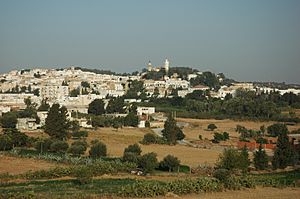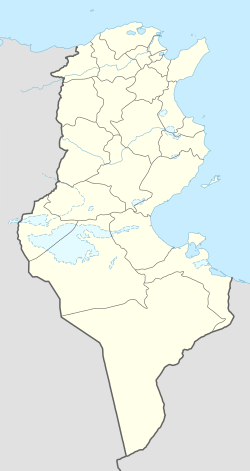Zaghouan facts for kids
Quick facts for kids
Zaghouan
زغوان
ⵣⴻⵖⵡⴰⵏ
|
|
|---|---|

Zaghouan Governorate
|
|
| Country | |
| Governorate | Zaghouan Governorate |
| Delegation(s) | Zaghouan |
| Population
(2022)
|
|
| • Total | 22,637 |
| Time zone | UTC+1 (CET) |
Zaghouan (also called Zaghwan) is a town in the northern part of Tunisia. Its name in Arabic is زغوان and in Berber it's ⵣⴻⵖⵡⴰⵏ / Zeɣwan.
The town sits on a low ridge of the Dorsale Mountains. It has a mild climate and looks very green. Zaghouan is famous for its beautiful roses. These roses were first grown by Muslim refugees from Spain in the 1600s.
Zaghouan is about 60 kilometers (37 miles) south of Tunis. It is also about 50 kilometers (31 miles) west of the Gulf of Hammamet. In 2022, about 22,637 people lived there. Zaghouan is the capital city of the Zaghouan Governorate.
Contents
Ancient Water Supply
Zaghouan was very important in ancient times because of its water. Cold, fresh water from here was carried all the way to the city of Carthage using a special structure called the Zaghouan Aqueduct.
Roman Water Temple
South of Zaghouan, on a mountain called Djebel Zaghouan, you can find the ruins of a Roman Water Temple. This temple was the starting point for the aqueduct. The aqueduct was an amazing engineering feat that brought water to Carthage, which was over 100 kilometers (62 miles) away!
History of Zaghouan
Zaghouan is believed to be the ancient city of Zica (or Ziqva). This city was important during the time of the Roman Empire. It was part of the Roman province of Africa Proconsularis.
Ancient Bishops
In ancient times, Zica had its own bishops, who were important religious leaders.
- One bishop, named Donatus, attended a big meeting in Carthage in 411 AD.
- Another bishop, Vincentius, was part of a meeting in Carthage in 484 AD. After this meeting, he and many other Catholic bishops were sent away by the Vandal king.
Climate in Zaghouan
Zaghouan has a warm climate. The summers are hot and dry, while the winters are mild and wet. Here's a quick look at the weather:
- Hottest Month: July, with average temperatures around 27.6°C (81.7°F).
- Coldest Month: January, with average temperatures around 10.8°C (51.4°F).
- Rainy Season: Most rain falls from October to March.
- Sunny Days: Zaghouan gets a lot of sunshine, especially from May to August.
Images for kids
See also
 In Spanish: Zaghouan para niños
In Spanish: Zaghouan para niños





